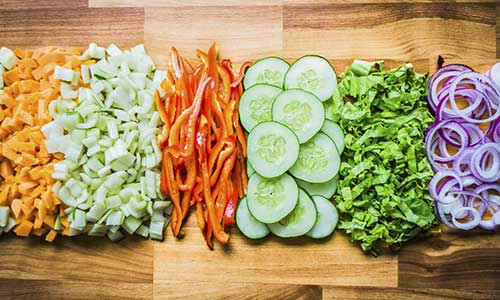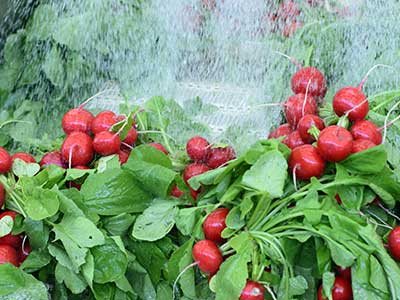Bagged Salad Producer
A supplier of bagged salads approached us in 2015 to see if we could help them streamline their disinfection process and save costs.
The company produces various products for a number of clients. This includes privately labelled items for some well-known supermarkets.
They had a total of seven washers plus one plunge bath. The latter was used to wash a variety of salad leaves, shredded carrots and cabbage. At the time, they had tried various disinfection methods.
First steps
Initially, we undertook a small trial involving just one washer. The aim was to see how we could control the disinfectant levels of water in the machine using commercial sodium hypochlorite as a disinfectant and citric acid to maintain optimum pH levels.
We were able to prove that a better designed system would perform more reliably, and that as a consequence the level of microbial reduction was more consistent compared with previous techniques.
Main project
Following this success, the main challenge for Prodose was to provide a full-scale system that would control the levels of disinfectant in all seven washers and the bath, with each of these systems being individually monitored and dosed.
Cost savings
We installed the Ampro electrochlorination system. This enabled the client to manufacture sodium hypochlorite from salt on site as required. This had the benefit of reducing their dependence on chemical suppliers and helped to cut costs, given the relatively low cost of salt.
This low strength sodium hypochlorite solution is also relatively pH neutral, so we also installed a small citric acid dosing system in order to maintain pH levels. This also helped improve reliability by reducing the fluctuations in pH level.
Downtime reduced
In order to minimise downtime, the system was designed to treat the incoming water with sodium hypochlorite and citric acid as it entered the machines. This ensured that the water feeding each individual washer had a level of residual disinfection in line with the requirements of the produce being washed.
The fact that incoming water was at or close to the required levels of disinfectant had the effect of massively reducing “dwell time” – those periods during which the system pauses and waits for the dosing process to add more disinfectant to the water.
Constant monitoring
The washers were fed from a cold-water storage tank. This tank was fitted with a combined pH and free chlorine residual analyser. The system used the data fed back from this device to control the addition of sodium hypochlorite and citric acid, ensuring it was constantly maintained at the correct level before the water was distributed to the washers.
Each washer was then fitted with a free chlorine residual analyser, a device to measure the chlorine levels in the water. Each of these devices monitors the chlorine levels constantly.
As chlorine is consumed, a control algorithm calculates how much disinfectant is needed to replace it and activates a sodium hypochlorite dosing device, which adds a controlled amount of chlorine into each washer.
Data for traceability
The client could now use data from the system to evaluate how well it was performing, and to archive for future reference. Should there be any issues regarding contamination of products after they left site, the client would be able to produce records to demonstrate that the disinfectant level had been maintained on a specific date.
As well as the peace of mind from having a fully traceable system, the client was now able to achieve a higher level of productivity, as well as minimising costs from only having to purchase salt.
Overall, a this has been a very successful project – and something we can replicate for any food processor who currently does not have an automated disinfection system.
If you are interested in upgrading your system in this way, please get in touch with us at Prodose. We’d be very happy to talk to you confidentially and on a no-pressure basis.


Further Case Studies
Major UK Stadium Case Study
Case Study: Stadium water supplyThe dosing of water supplies with chlorine dioxide is a very common and effective method of preventing Legionella within buildings and facilities. Prodose has recently specified and installed a chlorine dioxide generation system in a...
Recent Articles
Why is Electrochlorination the Best Choice for Swimming Pool Disinfection?
Why is Electrochlorination the best choice for swimming pool disinfection?All swimming pools should be regularly and thoroughly disinfected. This eliminates harmful pathogens that cause sickness in swimmers and prevents the growth of other biological organisms, such...
What is the Electrochlorination Process?
What is the Electrochlorination process?Electrochlorination is the process of applying an electrical current to salt water to produce dilute sodium hypochlorite (bleach) and hydrogen gas. The resultant sodium hypochlorite solution contains between 0.7%-1% chlorine....
Chlorine Dioxide and Legionella Control
Chlorine Dioxide and Legionella ControlLegionella is a bacterium found in soil and water. When it occurs outdoors, it usually does so in low concentrations and doesn’t cause problems. However, when it grows inside artificial water systems, such as hot tubs, hot water...
Chlorine Dioxide and Water Treatment for Plant Nurseries
Chlorine Dioxide and Water Treatment for Plant NurseriesHorticultural facilities, such as plant nurseries, face many of the same water sanitation issues as their agricultural counterparts. These issues include keeping ornamental and food plants healthy, maintaining...
Keeping it clean: the use of Chlorine Dioxide in the Food and Beverage Sector
Keeping It Clean: the use of Chlorine Dioxide in the Food and Beverage SectorChlorine dioxide is rising in prominence as the best water treatment additive for the food and drinks industry. It’s powerful and economical, and may be a more practical solution for...
Chlorine Dioxide: the practical choice for water treatment in the UK
Find out about Chlorine Dioxide and why it makes such an effective water treatment for the food industry and other industrial practices.
If you are interested in upgrading your system in this way, please get in touch with us at Prodose. We’d be very happy to talk to you confidentially and on a no-pressure basis.
